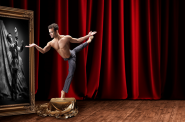Milwaukee Ballet’s Innovative Motion
The relentless drive of Tim O’Donnell’s Bolero — Let There Be Light set the Milwaukee Ballet‘s big Thursday night crowd to cheering, and for good reasons.
O’Donnell’s choreography and 10 company dancers (5/5 by gender) summoned constantly rising energy to match Ravel’s music. It’s not just that the steps were complex and dense and often very fast. They executed those steps and gestures in a tightly bound way. At no point did a dancer toss a loose, carefree limb. Every arc of an arm, every twist of a torso, every traveling step bespoke effort, control and resistance.
And yet, those movements did not express strain, which would have been unpleasant. The musicality in the design of the dance and in the dancing projects taut, elastic strength. Seeing and empathizing with that strength are great pleasures.
They are serious pleasures, too. O’Donnell establishes high seriousness in a prologue with voice-overs by controversial Buddhist meditation master Chögyam Trungpa, an anti-religious rant by Jordan Maxwell and the opening bit of an anti-religious comedy routine by George Carlin. Carlin’s vivid description of hell drove Michael Linsmeier’s intense fluttering of hands around a writhing body, indicative of burning torment. That solo, another by Patrick Howell and some ensemble prayerful gestures (the sign of the cross, “flying” hands representing a rising dove) laid out most of the raw material of the Bolero.
O’Donnell throws nothing away. Primarily through ever more complex contact partnering, he expands, refaces, builds counterpoint and changes speeds in transformative ways, all with limited materials that become more and more familiar even through ever more fantastical guises. This is how form works in dance. This is why Bolero — Let There Be Light feels as coherent as a single, perfect punch rather than wild swings in all directions. This is why Bolero is uncommonly powerful.
O’Donnell’s work seemed all the more powerful in contrast with Salvatore Aiello’s gentle, whimsical Clowns and Others.
These are European-style clowns, given to pathos and mime rather than horn-honking and slapstick. Douglas Barger’s witty gold/silver-on-white costumes, suggestive of harlequin and columbina, set the tone. Each of the seven men and seven women have distinctive white headgear: caps with outsized bills, enormous bows, a cloche, a derby or two, a pillbox. Luz San Miguel is so cute in a propeller beanie that she should wear it all the time.
Luc Vanier’s Sur-Rendered brings computer imaging in real time to the dance stage. The dancers wear wireless electrodes. A computer, via digital cameras, detect the motion of the electrodes. Their movements control images projected onto a backdrop and, later in the piece, on a transparent scrim at the front of the stage.
At first, the relation was obvious, as the petals of floral images opened and closed with the opening and closing of dancers’ limbs. In a second section, it was harder to see how bouncing — what? cabbages? — tracked with dancer activity. Eventually, I think I grasped some connections; Sur-Rendered is, to some extent, a puzzle dance.
Sometimes, though, it’s hard to decide what to watch: The lights dancing about? Or the dancers knocking themselves out on the stage? The imagery had a way of making the dancers look small, and that’s not good. (They showed great amplitude in the other pieces.) Vanier puts a lot before your eyes; this is a high-energy piece. But it’s not aimed at a climax and more or less plays out at one level, especially during the long, beat-heavy central sections.
Frankly, I started to drift off during that stretch, but got interested again when Jacqueline Mosicke came out with this wacky rocker device booted to her left foot. It made her four inches taller; the taller Rachel Malehorn looked mad-queen regal in it to open the piece. In addition to regality, the airfoil-shaped device, about as wide as a water ski and maybe 20 inches long, allowed them to rock in various ways and turn with startling abruptness. What a quirky, intriguing bit of invention from Vanier, and how game the dancers were to climb aboard and dance with such gusto.
Innovative Motion, at the Pabst Theater, will be repeated at 7:30 p.m. Friday, 1:30 and 7:30 p.m. Saturday, and 1:30 p.m. Sunday. Call the Pabst box office, 414-286-3663 for tickets.
Dance
-
Milwaukee Ballet Brings Back Orchestra
 Jul 14th, 2025 by Bruce Murphy
Jul 14th, 2025 by Bruce Murphy
-
New Riverwest Company, Production Impresses
 Feb 10th, 2020 by Brendan Fox
Feb 10th, 2020 by Brendan Fox
-
Milwaukee Ballet Show Remakes History
 Feb 10th, 2020 by Catherine Jozwik
Feb 10th, 2020 by Catherine Jozwik
























Dear Tom,
I so appreciate your commitment to writing about dance. You can read my response on Sur_Rendered’s blog here:
http://tinyurl.com/yd5plj5
All the best, Luc.
It really, really was an amazing show!
Birthday Poem for the Ballet’s 40th
“Three Princes Dancing in Hell”
My three princes dancing the Bolero at Valentine’s Day…
After such dreadful blasphemies, must be dancing in Hell.
Everything is black and red. The star system is gone.
The feminine archetypes are indistinguishable – lithe brunettes, –
Spinning, whirling souls in purgatory with the princes…
Clockwork precision, break-leg timing, technical mastery.
Need I mention how handsome that Patrick Howell is,
His proportions perfect in my opera glass?
He’s the dutiful partner, the cooperating ensemble member,
But I wish I could slide my chest against his in Bolero.
How beautifully he kissed the Sleeping Beauty in the 2008 brochure!
Did I mention how elegant that David Hovhannisyan is,
My Seigfried, my classical prince? He is so long-limbed,
When he unfurls he is a shooting star, five-pointed,
Arcing, spinning, whirling through space.
I can’t take my eyes off of him.
Oh that sweet, Ryan Martin,
Such a tender, young, and sensitive prince,
A darling, repentant Albrecht, so gentle in his partnering.
But he is athletic and strong, so wholesome
He might have been a hockey player in another life.
Did Michael Pink import these princes from the world over,
Or, were they “made in Wisconsin”?
The company has never been smaller, but it’s never been better.
After seven years, a biblical number, Michael achieved his vision:
An ensemble of excellence; every dancer a soloist or leading artist.
What the Hell? Why don’t we shout; it’s been here forty years?
Milwaukee has a great international Ballet!
-CKS, 2010-